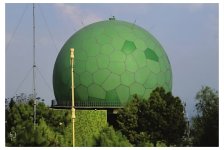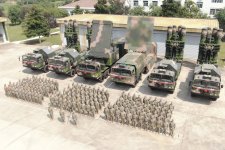CSAW
Full Member
- Mar 9, 2022
- 1,288
- 2,431
- Country of Origin

- Country of Residence

- Thread starter
- #61
Taking a Holistic Approach to Area Denial - QUWA March 2024
In 2019, the PAF had largely leaned on its fighter fleet to deny enemy aircraft access and control of its airspace. Surface-to-air missiles (SAM) did not figure much in the PAF’s approach, especially as its longest-range ‘vector’ at the time was the MBDA Spada 2000-Plus, which had a range of 20 km.
PAF mostly used its SAMs to protect installations, not deny – much less deter – enemy air activity near or across the national border. While it continued investing heavily in fighters since 2019, the PAF also revealed that it built a new and robust ground-based air defence system (GBADS).
AHQ likely appreciated Ukraine’s deft use of GBADS as a way of mitigating enemy air power over one’s territory and, in turn, adopted the idea to defend Pakistani airspace.
However, it is worth noting that in addition to medium- and long-range SAMs, the PAF also set the groundwork for leveraging directed energy weapons and passive air defence measures. This was likely done to address the threat of loitering munitions and swarming drones.
Surface-to-Air Missiles
The PAF is no longer relying on only fighter aircraft for area denial; rather, SAMs will help improve its first-response mechanism against enemy air activity. To this end, the PAF has begun investing in both medium-to-long-range SAMs and long-range SAMs.Until recent years, the PAF’s primary SAM solutions were the MBDA Spada 2000-Plus, French Crotale 2000, and Mistral man-portable air defence systems (MANPADS). Traditionally, the PAF’s GBADS was not built for territorial defence, but point-defence over installations, like air bases and radar sites.
Now, however, the PAF considers its GBADS a crucial asset for territorial defence, one meant to work in close concert with its fighter fleet. The new PAF GBADS is a multi-layered system made up of long-range, medium-range, and short-range SAMs plus other active and passive anti-air systems, such as directed energy weapons (DEW) and electronic attack (EA) systems.
Building Dedicated Offensive Wings
The Balakot episode exposed the need for an improved rapid response, area-denial capability; hence why the PAF acquired the HQ-16FE medium-to-long-range SAM and HQ-9BE long-range SAM. These will augment the PAF’s growing force of AESA radar- and LRAAM-equipped fighter aircraft.However, building a retaliatory capacity was equally important for deterrence purposes. Mitigating a cross-border strike is not enough, but in Pakistan’s view, it must be followed up with a measured, yet impactful and rapidly employed, response. From Rawalpindi’s standpoint, establishing the threat of extensive conventional retaliation by air and from land could deter a future Balakot issue entirely.
To achieve this goal, the PAF likely concluded that it must build the capacity to support multiple Swift Retort-scale operations, be it in quick succession or simultaneously.
Operation Swift Retort leveraged a composite force of multirole fighter aircraft, AEW&C, and EA/ECM jamming aircraft. Through the rest of this decade, the PAF could orient more of its squadrons for the offensive role so that it can support more Swift Retort-type operations. The induction of the HQ-16FE and HQ-9BE could free up additional units (that might have otherwise been dedicated entirely for an air defence function) to take on more strike/attack duties. Chief among these units would be the JF-17C and J-10CE squadrons; the Bayraktar Akıncı may complement them as a SOW carrier (that would deploy ALCMs and gliding PGBs from a safe distance within Pakistani territory, like the Mirages did).
The near-term composition could involve the J-10CE in the top-cover and the JF-17B, JF-17C/Block-III, and Akıncı in the strike roles, respectively. Potentially, the JF-17 Block-II may be upgraded with an AESA radar, updated avionics suite, HMD/S, and improved ECM capability. However, the Block-II may be employed for the defensive area-denial role (alongside the F-16s and JF-17 Block-Is).
However, this composition would only be effective in this decade. India is also building a robust – if not standard-bearing – area-denial capability through a plethora of advanced SAMs (e.g., Barak-8) as well as cutting-edge 4+ fighters, like the Rafale and Tejas Mk1A. The PAF likely anticipates a markedly tougher threat environment in India in the future, hence why it is now actively bringing NGFAs into the conversation. The Shenyang J-31 is at the center of this push.
HQ-9BE
In its promotional video, the PAF confirmed that it inducted the HQ-9BE, a long-range SAM system. It can intercept a variety of target types, including:
- Combat aircraft at a range of up to 260 km and altitude of 27 km
- Air-to-ground missiles (AGM) at a range of up to 50 km and altitude of 18 km
- Cruise missiles at a range of up to 25 km and altitude greater than 0.02 km
- Tactical ballistic missiles (TBM) at a range of up to 25 km and altitude of 18 km

Unlike the older HT-XXX series of guidance radars found on the FD-2000, the HQ-9BE uses the JSG-400 TDR guidance radar, which is designed for TBM interceptions, and the JPG-600 TDR surveillance radar. Furthermore, the battery utilizes a command-and-control (C2) system and electronic counter-countermeasures (ECCM) system, plus several decoy vehicles.
The HQ-9BE is marketed as a limited theater air defence solution that could intercept fighter aircraft and long-range munitions. China Aerospace Science and Industry Corporation (CASIC) says that the HQ-9BE can intercept TBMs with ranges of up to 1,000 km. The HQ-9BE can respond against TBMs in 10 seconds and non-TBMs within 15 seconds. It is basically the PAF’s most advanced SAM system.
The PAF specifically highlighted counter-TBM and counter-cruise missile capabilities. While this was likely in reference to the HQ-9BE, it may indicate that the PAF is interested in the idea of building anti-ballistic missile (ABM) capabilities in the long-term. The HQ-9BE could be the starting point.
HQ-16FE
In addition to the HQ-9BE, the PAF also revealed that it acquired the Chinese HQ-16FE, which is also designated as the LY-80B. This is a vastly improved variant of the LY-80 already in service with the Pakistan Army and the Pakistan Navy. The HQ-16FE seems to form the PAF’s medium-to-long-range air defence layer.

The HQ-19FE offers a range of 25 km to 160 km with a minimum/maximum intercept altitude of 15 m to 27 km against fighter-sized targets. It leverages a datalink-aided INS guidance system as well as a dual-mode semi-active and active-radar homing (SARH/ARH) seeker.

The HQ-16FE’s main guidance radar is a 2D active-scanning phased-array system with a range of 250 km against “normal” fighter-sized targets, likely in reference to a radar cross-section (RCS) of 5m2. It can simultaneously track 12 targets and engage 8 at once…
Enhancing Situational Awareness
The PAF is using a range of radars and passive sensors to build its situational awareness, not just over Pakistani territory, but, potentially, across its borders too.Multi-Layered Radar Coverage
The PAF’s radar coverages use a combination of land-based radars and airborne early warning and control (AEW&C) systems. Together, these assets monitor Paksitani airspace across multiple radar bands while also providing support for different missions, including offensive operations.Horizon-7
It appears that the PAF has begun designating its Erieye AEW&C as the ‘Horizon-7’. The PAF operates seven to nine Erieye systems, with the latest unit being inducted as recently as January 2024.
With the Saab 2000 as its aircraft platform, the Erieye is an S-band active electronically scanned array (AESA) radar with a range of 450 km. It also has five onboard mission operator consoles for managing connected air and surface assets for air-to-air and air-to-surface maneuvers.
Being an airborne radar system, the Erieye also gives the PAF with over-the-horizon (OTH) coverage, which it can leverage to monitor the airspace of its neighbours, especially India and Iran.
It appears that the PAF is standardizing its AEW&C fleet on the Erieye. Moreover, its latest unit – i.e., 23-058 – exhibited some different hardware compared to the PAF’s preceding Erieye units. This unit is unlikely to be the Erieye-ER, but it may have updates similar to Brazil’s E-99M, which is an upgraded Erieye system. That said, the PAF may seek the Erieye-ER in the future, but as an offensively oriented asset that can support its long-range strike wings.
YLC-8E
The PAF also confirmed that it has inducted the YLC-8E radar from the China Electronics Technology Group Corporation (CETC). The YLC-8E is marketed as an ‘anti-stealth radar system,’ but to the PAF, it likely serves as a land-based early warning radar system…

End of excerpt. Subscribe to Quwa Premium to read the rest of this section.
TPS-77 MRR
The PAF also confirmed that it inducted the Lockheed Martin TPS-77 Multi-Role Radar (MRR). While it did not disclose how many units it acquired, some observers peg the number at over 20 radars. The PAF acquired the TPS-77 MRR for its low-level gap-filler radar requirement…

End of excerpt. Subscribe to Quwa Premium to read the rest of this section.
Passive Sensors
The PAF confirmed that it inducted at least one passive sensor, among them the ERA VERA-E and a Chinese system (that may or may not accompany the CHL-906, as explained above)…
Last edited:



















